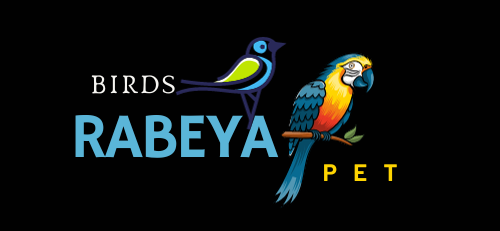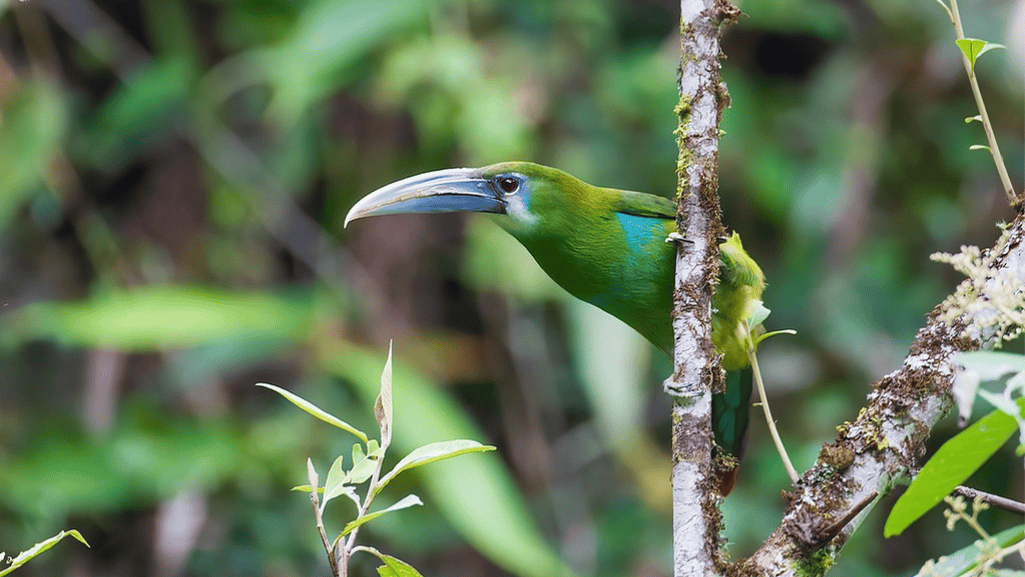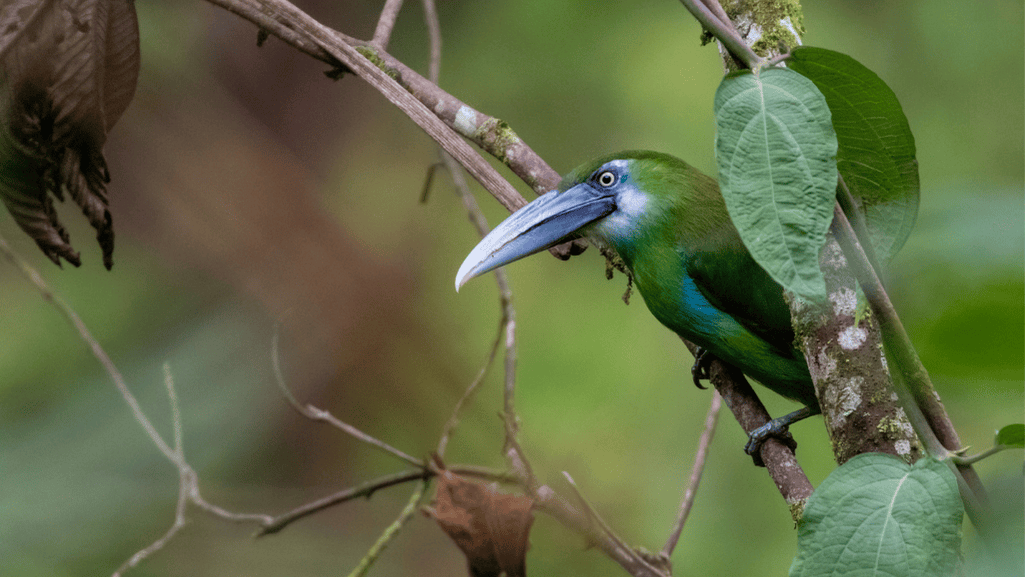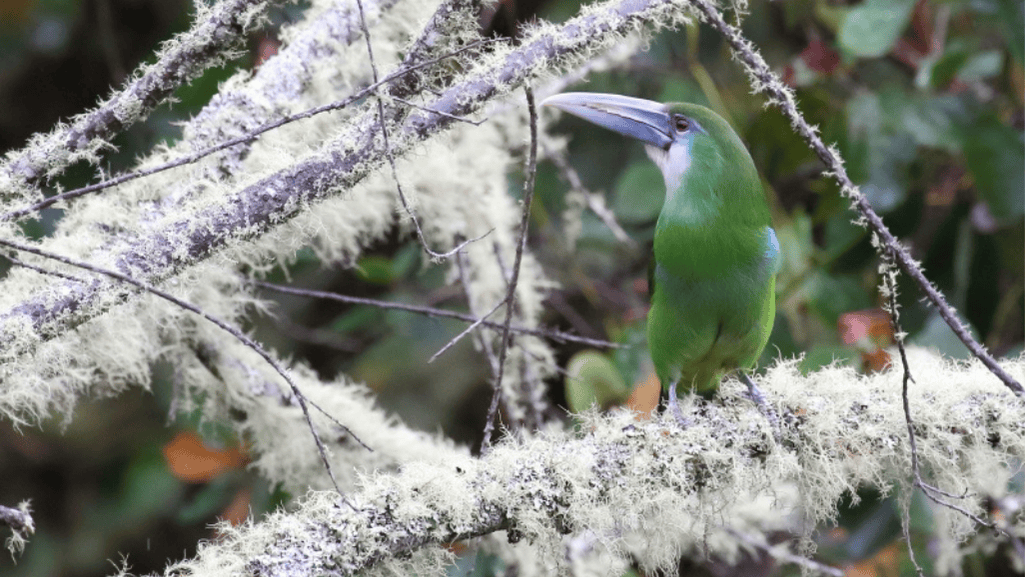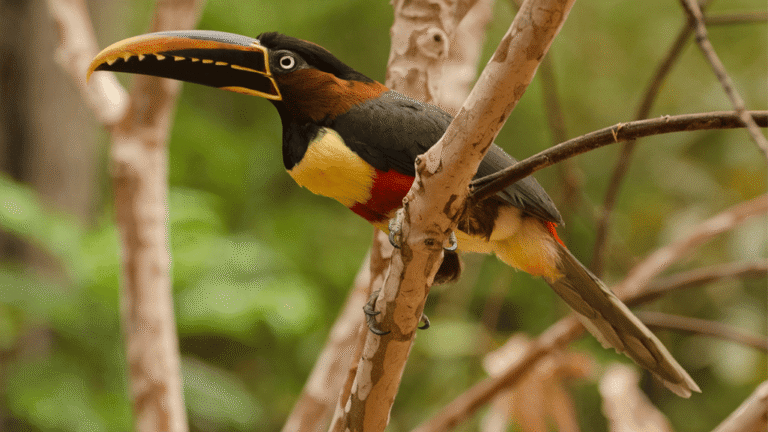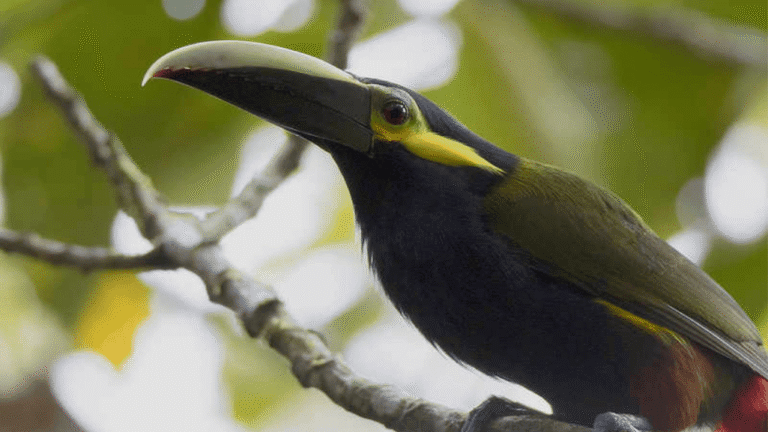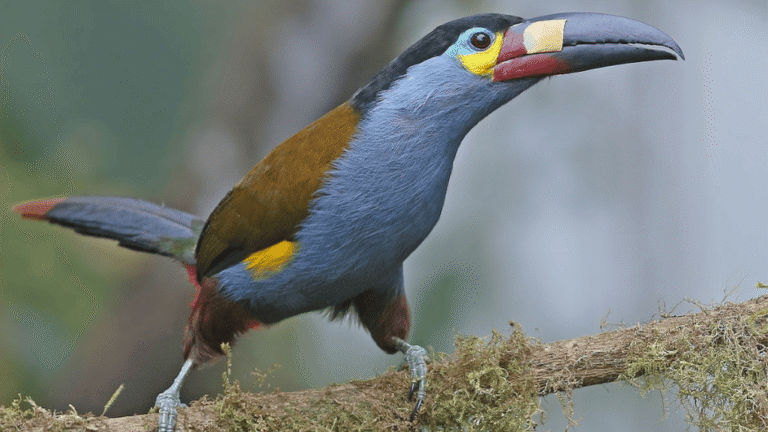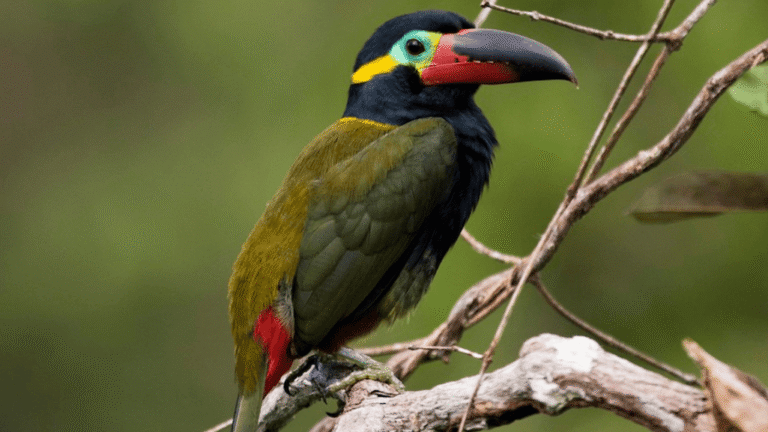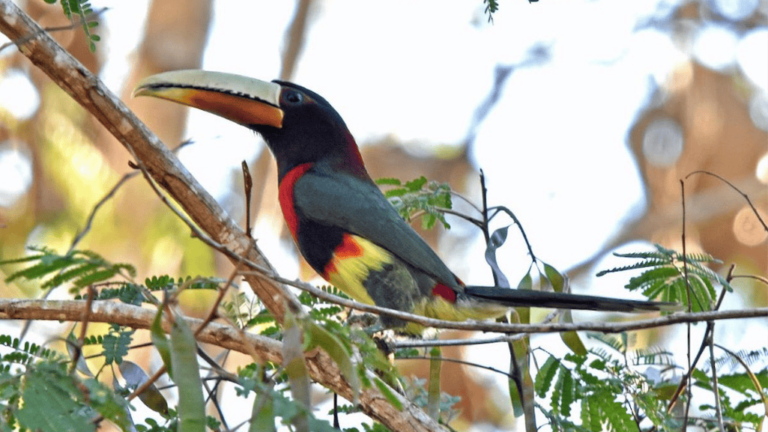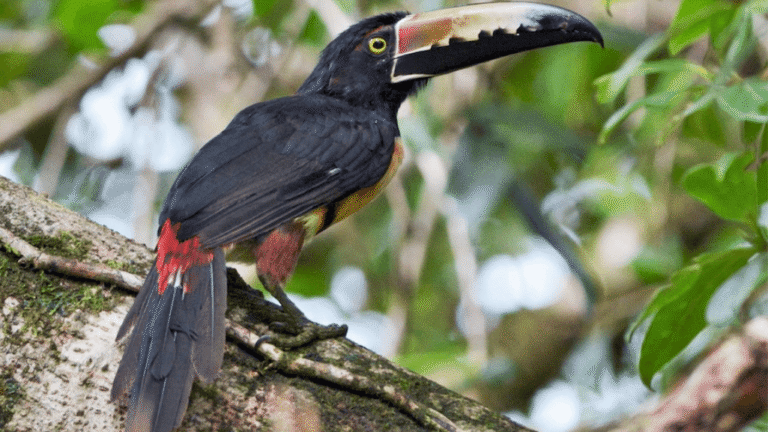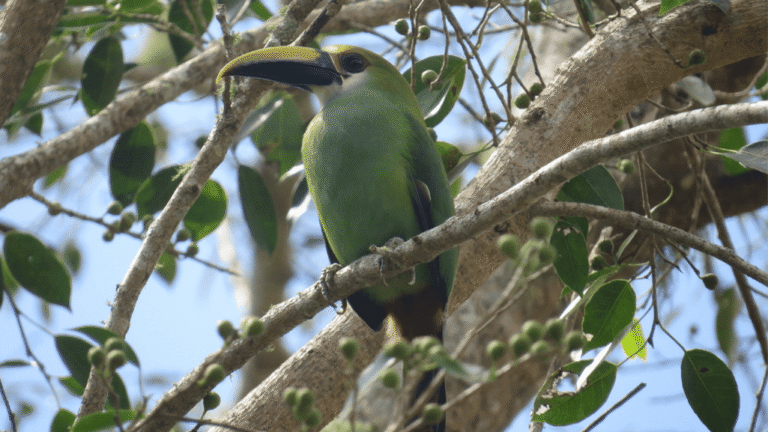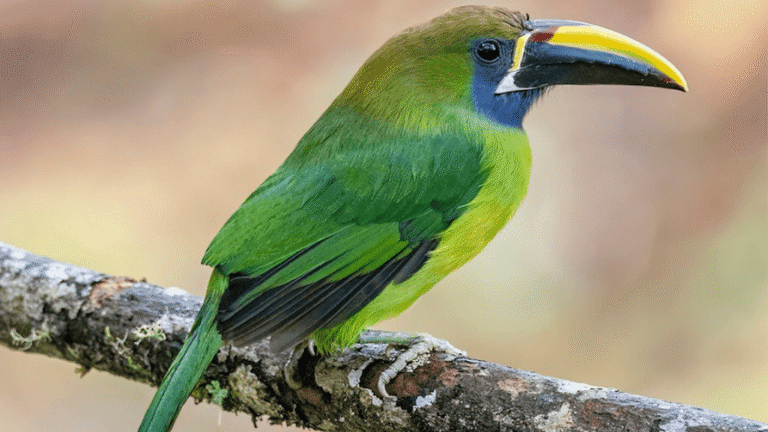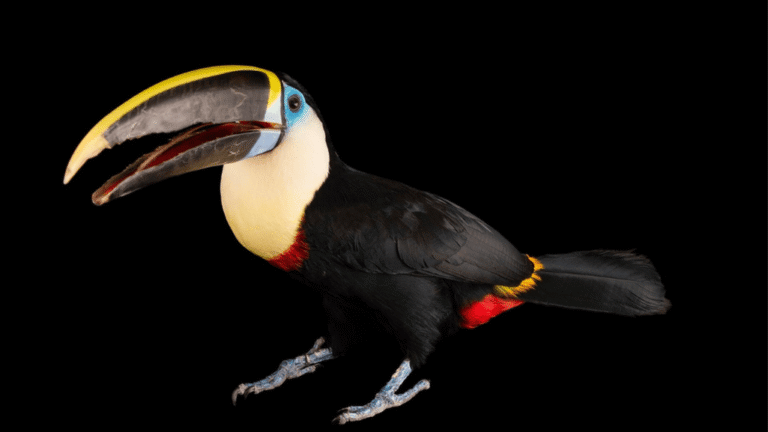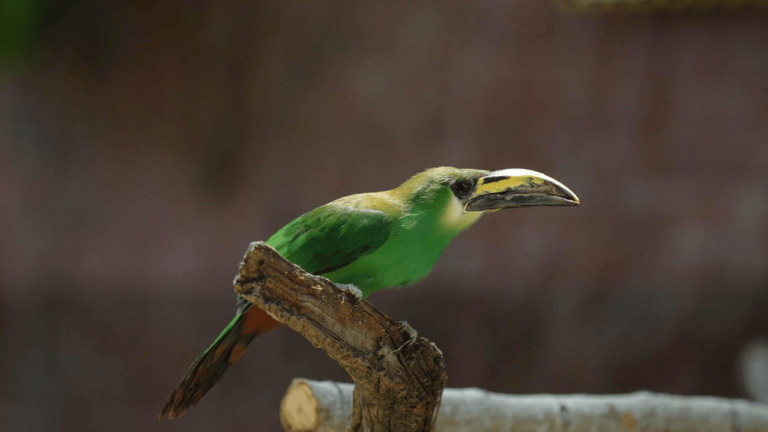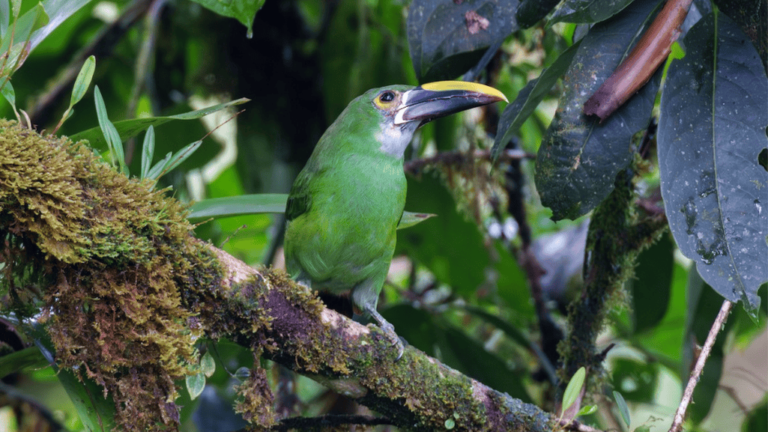The Blue banded toucanet aulacorhynchus coeruleicinctis, scientifically known as Aulacorhynchus coeruleicinctis, is a small, green toucan found in remote regions along the east slope of the Andes in northern Peru. This enchanting toucanet bird inhabits cloud forests that are currently inaccessible without a serious expedition, making encounters with this rare species uncommon.
The plumage of the Blue-banded Toucanet is primarily green, with a blue breast-band, a red rump and tail tip, and a white throat. It can be distinguished from other toucanets by the yellow streak above the eye and the vertical white stripe at the base of the bill. Its mostly black bill and blue breast-band help differentiate it from similar species like the Southern Emerald-Toucanet and Chestnut-tipped Toucanet.
Key Takeaways:
- The Blue-banded Toucanet is a small, green toucan found in the cloud forests of the Andes in northern Peru.
- Encounters with this rare species are uncommon due to its remote habitat.
- The plumage of the Blue-banded Toucanet is primarily green, with a blue breast-band.
- It has distinguishing features such as a yellow streak above the eye and a vertical white stripe at the base of the bill.
- The Blue-banded Toucanet is different from similar species like the Southern Emerald-Toucanet and Chestnut-tipped Toucanet.
Habitat and Distribution of the Blue-banded Toucanet
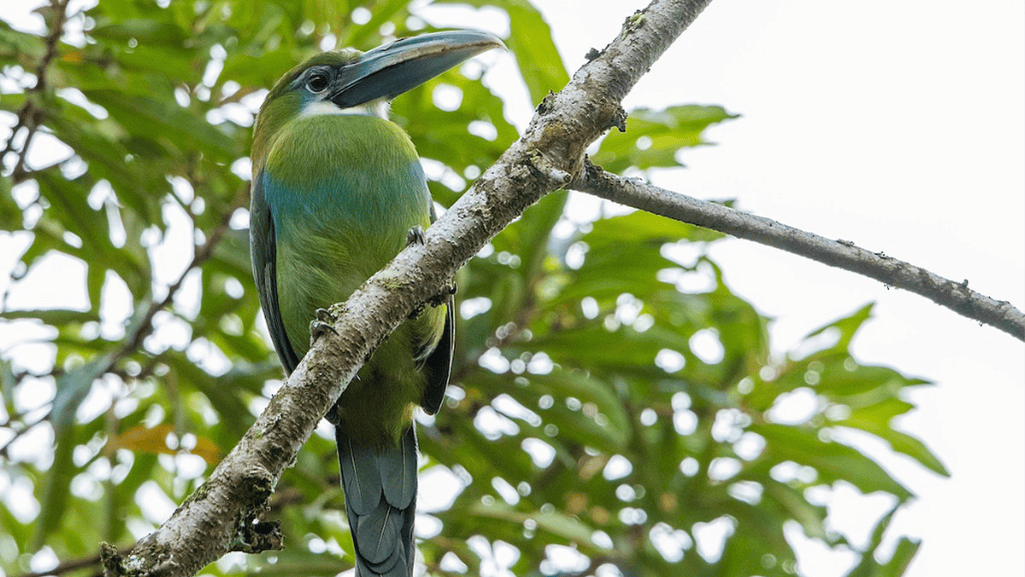 The Blue-banded Toucanet is a captivating bird that calls the cloud forests along the east slope of the Andes in northern Peru its home. These forests, known for their rich biodiversity and stunning natural beauty, are shrouded in mist and characterized by their dense vegetation. They provide the perfect habitat for the Blue-banded Toucanet, allowing it to thrive in its natural environment.
The Blue-banded Toucanet is a captivating bird that calls the cloud forests along the east slope of the Andes in northern Peru its home. These forests, known for their rich biodiversity and stunning natural beauty, are shrouded in mist and characterized by their dense vegetation. They provide the perfect habitat for the Blue-banded Toucanet, allowing it to thrive in its natural environment.
These cloud forests are renowned for their towering trees, which create a dense canopy that provides shelter and protection for a variety of wildlife species, including the Blue-banded Toucanet. The toucanets primarily inhabit primary forests, which are old-growth forests with large, mature trees. These trees often have natural cavities and holes that serve as nesting sites for the toucanets.
While the Blue-banded Toucanet primarily resides in primary forests, it may venture into secondary forests to forage for food. However, it is limited to areas with suitable breeding sites, as these forests lack the necessary nesting opportunities found in primary forests. This dependence on specific habitat requirements highlights the vulnerability of the Blue-banded Toucanet and emphasizes the importance of conserving its unique habitat.
The range of the Blue-banded Toucanet extends beyond Peru, with populations found in Southern Mexico to northern Argentina. However, it is important to note that the toucanets found in the Andes occupy temperate climates at high altitudes, adapting to the unique environmental conditions of their mountainous homes.
Blue-banded Toucanet Habitat Characteristics
To better understand the Blue-banded Toucanet’s habitat preferences, let’s take a closer look at its key characteristics and requirements:
- Primary forests: The Blue-banded Toucanet primarily inhabits primary forests, which provide the necessary nesting sites. These forests consist of mature trees that have existed for many years, ensuring a stable and safe environment for the toucanets.
- Large old trees: The toucanets rely on large old trees for nesting, as these trees often have cavities and holes that serve as natural nesting sites. The presence of suitable nest sites is crucial for the reproduction and survival of the Blue-banded Toucanet.
- Cloud forest ecosystem: The Blue-banded Toucanet is intricately connected to the cloud forest ecosystem, which encompasses a diverse range of flora and fauna. The abundance of fruits and insects found in this ecosystem supports the toucanet’s diet and provides essential resources for its survival.
- High altitudes: The toucanets found in the Andes inhabit temperate climates at high altitudes. These mountainous regions have their own unique environmental conditions, such as cooler temperatures and specific vegetation types, which the Blue-banded Toucanet has adapted to over time.
The Blue-banded Toucanet’s habitat is not only home to this remarkable species but also plays a vital role in supporting the overall biodiversity of the cloud forests. Protecting and conserving these habitats is essential for the long-term survival of the Blue-banded Toucanet and countless other species that rely on these unique ecosystems.
| Habitat Characteristics | Details |
|---|---|
| Preferred Forest Type | Primary forests with large old trees |
| Nesting Requirements | Large old trees with cavities and holes |
| Ecosystem | Cloud forests with diverse flora and fauna |
| Altitude | Temperate climates at high altitudes in the Andes |
blue banded toucanet aulacorhynchus coeruleicinctis
The Blue-banded Toucanet is a fascinating bird with unique feeding habits. As a frugivorous species, its diet primarily consists of fruits, playing a crucial role in seed dispersal for fruiting trees. However, the Blue-banded Toucanet is also known to be opportunistic in its feeding behavior.
While fruits make up the majority of its diet, they have also been observed consuming insects, smaller birds, and small lizards. In captivity, Blue-banded Toucanets have shown their adaptability by actively hunting insects. This indicates their ability to diversify their diet when necessary.
Another interesting feeding behavior of toucans, including the Blue-banded Toucanet, is their tendency to raid the nests of smaller birds. They consume eggs and nestlings, providing them with an additional source of protein. This opportunistic behavior highlights their ability to adapt to different food sources in their environment.
To illustrate the dietary preferences of the Blue-banded Toucanet, here is a comprehensive table that showcases its main food sources:
| Preferred Foods | Additional Foods |
|---|---|
| Fruits | Insects |
| – | Smaller birds |
| – | Small lizards |
As frugivores, the Blue-banded Toucanet plays an essential role in maintaining the ecosystem’s balance. Their feeding habits contribute to seed dispersal, allowing for the growth and regeneration of fruiting trees in their natural habitat.
Additional Notes on Feeding Behavior:
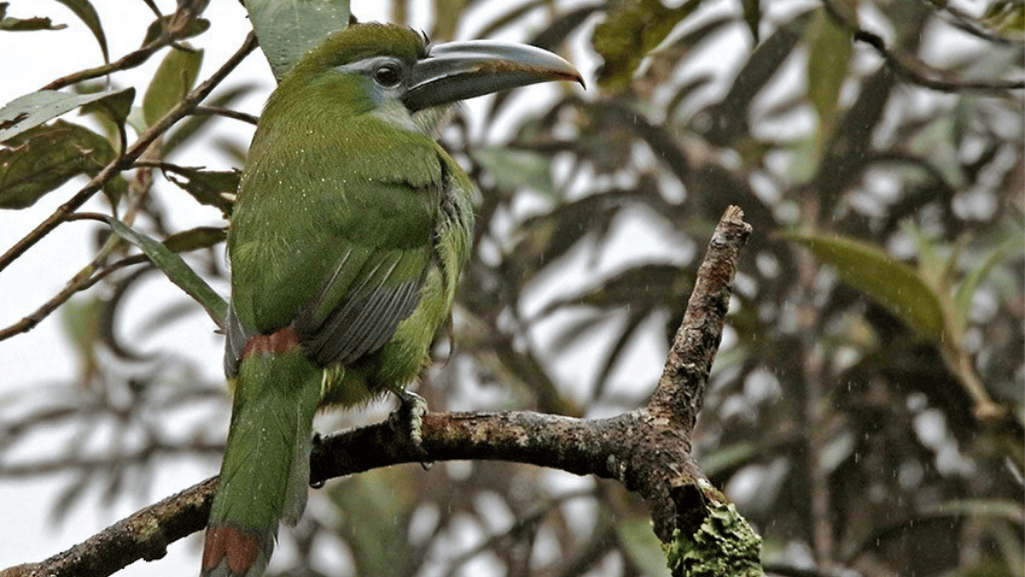 – Toucans have a unique feeding technique where they snatch fruits with their bill and toss them into the air before swallowing them whole.
– Toucans have a unique feeding technique where they snatch fruits with their bill and toss them into the air before swallowing them whole.
– The large size of the Blue-banded Toucanet’s bill allows it to access fruits that are too big for other birds. This gives them an advantage in reaching a wide variety of food sources.
– The feeding behavior of this species also includes social interactions, such as feeding one another during courtship rituals or sharing food with their offspring.
Behavior and Characteristics of the Blue-banded Toucanet
Blue-banded Toucanets are highly social birds that are often found in pairs or small flocks. They exhibit a range of interesting behaviors, which include sparring with their bills, engaging in tag-chasing games, and vocalizing during the digestion process of fruits. These behaviors are believed to play a role in establishing dominance hierarchies within the group and maintaining strong pair bonds.
Toucans, including the Blue-banded Toucanet, are recognized for their distinctive bills. These bills are large, colorful, and possess serrations that resemble teeth. What makes these bills truly unique is their composition. Comprised of bone struts filled with spongy keratin, they are lightweight and well-suited for thermoregulation. Additionally, the bill’s structure enables toucans to access food hidden in tree holes and potentially intimidate smaller birds.
To gain a better understanding of the fascinating behavior and physical characteristics of the Blue-banded Toucanet, refer to the table below:
| Toucanet Behavior | Toucanet Characteristics |
|---|---|
|
|
As seen from their behavior and characteristics, the Blue-banded Toucanet is a remarkable species worth observing and learning more about.
Conservation Status of the Blue-banded Toucanet
The Blue-banded Toucanet is an extraordinary bird that captures the imagination with its vibrant colors and unique characteristics. While currently classified as “Least Concern” by the International Union for Conservation of Nature (IUCN), the species remains rare, necessitating ongoing conservation efforts to secure its future.
One of the primary threats facing the Blue-banded Toucanet is habitat loss due to deforestation. As the cloud forests along the east slope of the Andes in northern Peru are gradually fragmented, the toucanet’s pristine habitat diminishes, leaving it vulnerable to population decline and local extinctions.
The inaccessibility of the toucanet’s range has provided some measure of protection. However, as deforestation continues to encroach upon its habitat, concerted conservation efforts become increasingly crucial. These efforts involve creating protected areas, promoting sustainable land-use practices, and raising awareness about the importance of preserving the cloud forests for both the Blue-banded Toucanet and the overall ecosystem.
Conservation Initiatives
The conservation of the Blue-banded Toucanet is a collaborative effort involving local communities, conservation organizations, and research institutions. Some of the key conservation initiatives include:
- Establishment of protected areas: Creating designated areas for the conservation of the toucanet’s habitat helps safeguard its home from further destruction.
- Habitat restoration: Reforestation projects aim to restore degraded areas, providing vital habitats for the toucanet and other endangered species.
- Education and outreach: Increasing awareness among local communities and visitors about the value of the cloud forests and the need to protect the Blue-banded Toucanet fosters a sense of stewardship.
- Research and monitoring: Collecting data on toucanet populations, behavior, and habitat requirements enhances understanding and guides targeted conservation efforts.
The concerted actions taken by various stakeholders contribute to the collective goal of ensuring the long-term survival of the Blue-banded Toucanet. By preserving its habitat and raising awareness about the importance of biodiversity conservation, we can secure a future where this magnificent bird thrives alongside other species in the beautiful cloud forests of the Andes.
| Threats | Conservation Actions |
|---|---|
| Habitat loss due to deforestation | Establish protected areas Implement sustainable land-use practices Raise awareness about the value of cloud forests |
| Fragmentation of cloud forest habitat | Restore degraded areas through reforestation Collaborate with local communities and organizations Research and monitor toucanet populations |
| Poaching and illegal pet trade | Enforce wildlife protection laws Support local livelihood alternatives Conduct targeted anti-poaching measures |
Conclusion
The Blue-banded Toucanet (Aulacorhynchus coeruleicinctis) is a captivating toucan species found in the remote cloud forests of the Andes in northern Peru. With its stunning green plumage, distinct blue breast-band, and unique bill, it is a remarkable bird worth exploring.
While the Blue-banded Toucanet primarily feeds on fruits, its adaptability is evident through its occasional consumption of insects and nest-raiding behavior. This species is highly social, often seen in pairs or small flocks engaging in bill sparring, tag-chasing, and vocalizations.
Currently classified as “Least Concern” by the International Union for Conservation of Nature, the Blue-banded Toucanet still requires protection efforts to safeguard its fragile habitat. Conservation measures are crucial to ensure the long-term survival of this rare and mesmerizing bird species.
FAQ
What is the scientific name of the Blue-banded Toucanet?
The scientific name of the Blue-banded Toucanet is Aulacorhynchus coeruleicinctis.
Where is the Blue-banded Toucanet found?
The Blue-banded Toucanet is found in the remote cloud forests of the Andes in northern Peru.
What is the habitat of the Blue-banded Toucanet?
The Blue-banded Toucanet primarily inhabits cloud forests with large old trees suitable for nesting.
What does the Blue-banded Toucanet eat?
The Blue-banded Toucanet is primarily frugivorous, feeding mainly on fruits. However, it may also eat insects, smaller birds, and small lizards.
What are the characteristics of the Blue-banded Toucanet?
The Blue-banded Toucanet has green plumage with a blue breast-band, a red rump and tail tip, and a white throat. It has a mostly black bill with unique yellow streaks above the eye and a vertical white stripe at the base.
How does the Blue-banded Toucanet behave?
The Blue-banded Toucanet is a social bird that is usually found in pairs or small flocks. It engages in behaviors such as sparring with its bill, tag-chasing, and calling to establish dominance hierarchies and maintain pair bonds.
What is the conservation status of the Blue-banded Toucanet?
The Blue-banded Toucanet is currently classified as “Least Concern” by the International Union for Conservation of Nature (IUCN), but it is considered rare and faces threats from habitat loss due to deforestation and fragmentation.
Why is the conservation of the Blue-banded Toucanet important?
The conservation of the Blue-banded Toucanet is important to ensure the long-term survival of this rare species and to protect its cloud forest habitat.

